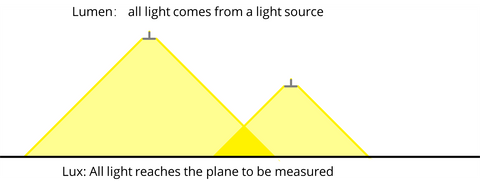
How to convert lumen and lux?
When you buy a lamp, you might wonder how much light it provides. It sometimes is indicated in Lumen which you can see on the outer packaging marked by the manufacturer. And sometimes it is indicated in Lux which interior designers mention when they explain how they design the house lighting. So, what are Lumen and Lux, and what’s the difference between them?
The difference between Lumen and Lux
Lumen usually indicates how much light the light source emits. Lumen is only related to the light source itself. A light source consists of a lamp or lamps that are in proximity.
Lux is used to describe how much light reaches the plane to be measured. This value is not related to the number of light sources, the distance from the light source, or even the directionality of the light source.
The image below shows how Lumen and Lux are different.

Why do we use Lumen and Lux?
Lumens are how much light is given off. It’s a parameter used on a datasheet or packaging to describe a light source. However, we often use multiple light sources when we design lighting distributions. A complicated area may involve multiple groups of light sources with different power. In this case, the designer converts lumens to Lux and calculates the light in the environment.
Lumen and Lux Conversion
It is not difficult to convert the lumen of a light source into lux. One lux is equal to one lumen per square meter (lux = lm / m2). what we need to do is to measure how big is the irradiated area.
The illuminated area is calculated from the distance from the light source and the beam angle of the light source.

In the face of multiple light sources, the calculation method of lux will become complicated. Usually, the lamp manufacturer will provide the IES file to describe the change of the lux of the lamp to facilitate the designer to design the lighting.
How to use lux in the lighting design
Usually, designers import IES into lighting design software like DIALux. After that, the software will automatically calculate the lux of any room position according to the lamps’ installation position. After that, the lux in some specific locations in the house must meet lighting standards. Different regions give different indoor lighting standards, such as the United States (ANSI/IESNA RP-11-1995), the European Union (EN 12464-1-2011), and China (GB50034-2013). Of course, these standards are only minimum. Satisfying these lighting designs is only acceptable. How to let the light shine where it is needed and avoid wasting it where it is not needed is what professionals need to handle.

Leave a comment